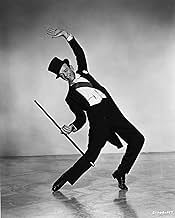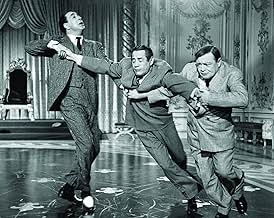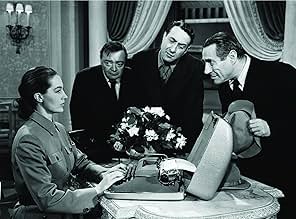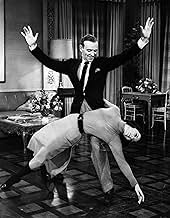Après que trois agents soviétiques maladroits aient échoué dans leur mission de récupérer un compositeur soviétique égaré de Paris, la belle et ultra-sérieuse Ninotchka est envoyée pour term... Tout lireAprès que trois agents soviétiques maladroits aient échoué dans leur mission de récupérer un compositeur soviétique égaré de Paris, la belle et ultra-sérieuse Ninotchka est envoyée pour terminer leur mission et les récupérer.Après que trois agents soviétiques maladroits aient échoué dans leur mission de récupérer un compositeur soviétique égaré de Paris, la belle et ultra-sérieuse Ninotchka est envoyée pour terminer leur mission et les récupérer.
- Réalisation
- Scénario
- Casting principal
- Récompenses
- 5 nominations au total
- Restaurant Patron
- (non crédité)
- Wife
- (non crédité)
- Soviet Guard
- (non crédité)
- Model
- (non crédité)
- Model
- (non crédité)
- Reporter
- (non crédité)
- Dancer
- (non crédité)
- Tenant
- (non crédité)
Avis à la une
That's the nuts and bolts of the story, but the ingredients (including a trio of Soviet agents played by PETER LORRE, JULES MUNSHIN and Joseph BULOFF and a ditsy American singer/actress JANET PAIGE), are enough to stir up a lot of sardonic humor and some really good song and dance numbers. Paige is especially good with her "Stereophonic Sound" routine and "Satin and Silk", flirtatious and vivacious as ever in a top supporting role.
But it's the dance elements that count here--Astaire at his most elegant and Cyd Charisse gracefully matching him step by step all the way through. Her performance as the serious minded miss who gradually bends to his ways is one of her better contributions to film comedy.
Summing up: A delightful blend of Cole Porter songs and a clever script make this one a sheer pleasure, smooth as silk.
The story is based on Ninotchka, the female Soviet commissar who comes to Paris and finds romance reluctantly...and then enthusiastically. Paris is presented as a place where decadence was never more innocent and persuasive.
One of the things that seems so odd is that, for a Fred Astaire film, Astaire spends a good deal of time doing knee drops, full-length on-the-floor sprawls and athletic dance moves that limit the sophisticated and smooth Astaire style. He was 59 when he made the picture, and this might explain the relative shortness of some of the sequences. Still, while he is assured and immensely watchable (and while he can still do wonders with a cane), three major dance productions he is in just seem choppy.
Most of the songs from the Broadway show were retained and Porter wrote a couple of new ones. It's become routine with Porter to say that whatever his latest show was, the score was never one of his best. In this case, it's true. The romantic songs are great, but the topical specialty numbers just seem tired. Siberia and The Ritz Roll and Rock in particular miss the mark, in my opinion.
Astaire, as always, is first class. Charisse is easy to look at and a fine dancer. George Tobias, as a commissar in Moscow and Ninotchka's boss, gives a sly and dead-pan performance. Some of Porter's songs are very good. Mamoulian brought the film in on time and under budget. And Silk Stockings was a success with ticket buyers.
Whether you like the main movie or not, the DVD extras have their own charm. The Special Features section includes a short film with Cyd Charisse as narrator, made about 2003, in which she talks about Cole Porter, Fred Astaire, and how the film came to be. Another short b/w film from the thirties is called "Paree, Paree". This one stars a very young Bob Hope, and features Cole Porter songs from the musical "20 Million Frenchmen".
Another musical treat is the "Poet and Peasant Overture", written by Franz von Suppe, played by the full studio orchestra. Both the 'Paree' film and this overture will tease you with musical strains familiar to those of us who grew up with old cartoons, so be warned! Listening to this music may induce animation flashback.
The film is a partial remake of Ernst Lubitsch's 1939 classic comedy, "Ninotchka" - in fact, some scenes are repeated verbatim - although certain elements have been altered to accommodate Cole Porter's musical score. This musical translation first showed up on Broadway two years earlier, but further revisions have obviously been made to tailor the story to the dancing talents of the leads. Charisse has the unenviable task of stepping into Greta Garbo's shoes as top Soviet envoy Ninotchka Yoschenko, who is sent to Paris to retrieve three lesser envoys swept up by the City of Lights. They had already botched their mission to lure famous Russian composer Peter Boroff back to the mother country. At the same time, American movie producer Steve Canfield wants Boroff to score his next picture, a musical bowdlerization of Tolstoy's "War and Peace" starring comically curvaceous Peggy Dayton, a parody of an Esther Williams-style swimming star whose been in the pool too long. As Dayton uses her feminine wiles to entice Boroff, Canfield tries to seduce Ninotchka, a far frostier proposition though the eventual thawing is inevitable. Porter's music has that effect or so we are led to believe.
Playing another variation on the worldly photographer he played in the same year's "Funny Face", Astaire is still at the top of his game, but his dance numbers are less elegant and appear markedly shorter than usual here. Charisse cannot compare to the legendary Garbo when it comes to line readings as a stoic communist. However, her dancing truly transcends not only the title tune but also "The Red Blues", an impressive ensemble number showcasing Charisse in a variety of dance styles, and the two duets with Astaire to "All of You" - the first a romantic defrosting of Ninotchka and the second a jauntier, rhythmic pas-de-deux. I wish the rest of the film was as good, but sadly, the energy wavers and the pacing flags during its 117-minute running time. The rest of the cast is serviceable, in particular, Janis Paige on familiar ground as Peggy (nicely paired with Astaire on the energetically cynical "Stereophonic Sound") and George Tobias as the deadpan Soviet commissar. Peter Lorre ("M") and Jules Munshin (Ozzie in "On the Town") show up as two of the bumbling envoys. The 2003 DVD has some interesting extras beginning with a ten-minute featurette featuring a 2003 interview with the still-elegant Charisse in "Cole Porter in Hollywood: Satin and Silk". Because of the Porter tie-in, there is also a 1934 Bob Hope short, "Paree, Paree", a silly musical comedy with Hope wooing singer Dorothy Stone. Also included is the original theatrical trailer, as well as "Poet and Peasant Overture" with Alfred Wallenstein conducting the MGM symphony orchestra playing the Franz Von Suppe piece as an overture to the movie.
A characiture of the USSR and America of the Cold War period? Yes indeed, and it was almost as good as "One, Two, Three" in its dialogue and situation. Its sensuality as presented in its dance numbers far exceeded the 1939 version and all comers of the same subject.
I had no problem watching a 56 year old Astaire romancing a 36 year old Charisse. As a matter of fact, I found the pair quite sensuous.
I have often wondered why in the final dance scene Cyd's costume skirt was switched to a cullote in the middle of the scene. The switch was not seamless as it was very noticeable.
But, all in all I give this delightful musical a rating of 8 on a 0 to 10 scale.
Dave
Le saviez-vous
- AnecdotesAfter this film, Fred Astaire effectively retired from musicals, preferring to concentrate on non-musical roles, though he would produce several musical specials for TV in the next few years. He wouldn't make another musical until La Vallée du bonheur (1968).
- GaffesIt becomes fairly obvious during the "Fated to be Mated" duet between Fred Astaire and Cyd Charisse that Charisse is wearing a skirt one moment and culottes (or flared shorts) the next. The bottom half of her costume changes on each cut of the dance when they are doing deep knee bends, and this is where the culottes show. For the upright spins and lifts, the skirt shows. The dance was obviously performed twice and edited into one sequence.
- Citations
Vassili Markovitch, Commisar of Art: I want to look somebody up. Does this office have a copy of Who's Still Who?
- ConnexionsEdited into Histoire(s) du cinéma: Une histoire seule (1989)
- Bandes originalesI've Got You Under My Skin
(1936) (uncredited)
Music by Cole Porter
Heard at the beginning as Steve and Boroff arrive at the hotel
Meilleurs choix
- How long is Silk Stockings?Alimenté par Alexa
Détails
Box-office
- Budget
- 1 853 463 $US (estimé)
- Montant brut mondial
- 9 755 $US
- Durée1 heure 57 minutes
- Mixage
- Rapport de forme
- 2.35 : 1

































